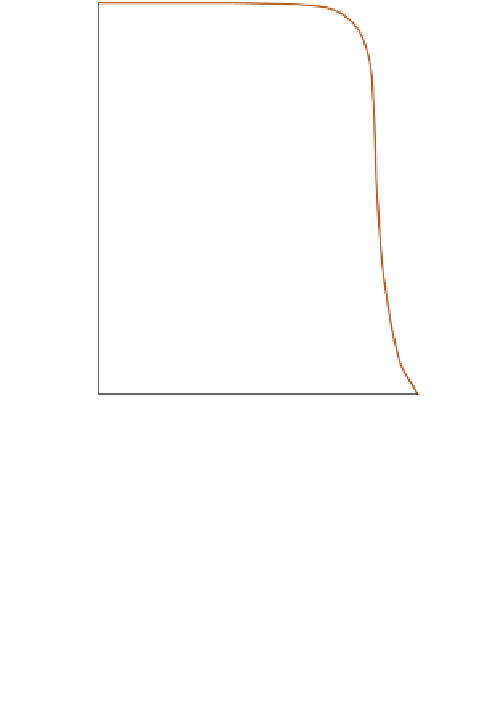Geoscience Reference
In-Depth Information
1.0
Evapotranspiration from land surfaces
Because of the importance of the energy and water
balances to growing crops, there have been a large number
of studies of evapotranspiration from vegetated surfaces.
The presence of a vegetated surface complicates the energy
exchanges taking place, however, for the plants intercept
radiation and rainfall inputs, they affect the temperature
and wind profiles near the ground, and they also modify
humidity. The degree of these effects varies with the
character of the vegetation, so evapotranspiration from a
vegetated surface often differs markedly from PE.
So long as moisture is available in the soil, the plants
are able to transpire at or very close to the potential rate.
Thus, in a moist soil, evapotranspiration proceeds
unhindered, water being drawn up the plant from the soil
to replace that lost from the leaves, particularly in the
canopy layer towards the top of the plants. As the soil dries
out, however, the plant experiences increasing difficulty
in extracting moisture and the rate of transpiration cannot
be maintained. Several changes take place. The plant starts
to suffer from moisture stress and nutrient deficiencies,
and in some cases the stomata in the leaves may close,
reducing transpiration further. But the drain upon the soil
moisture store continues, so the moisture stress gets worse.
Progressively the rate of actual evapotranspiration falls
below PE to develop a soil moisture deficit.
It now seems clear that the effect of declining mois-
ture availability depends upon a variety of conditions,
including vegetation type, rooting depth and density, and
soil type. In a heavy clay soil, for example, it seems that
evapotranspiration rates fall only slightly as the soil dries
out until the point is reached where no more water is
available to plants. Evapotranspiration then falls rapidly.
Conversely, in sandy soil the decline in actual evapotran-
spiration rates is much more regular (
Figure 5.20
),
as the
sandy soil's capacity to retain moisture is less than that
of clay.
0.8
Clay
1
2
0.6
E
PE
Sand
0.4
0.2
0.0
0.1
0.5
1
2
5
15 Bars
Soil suction
Field
capacity
Wilting
point
potential evapotranspiration E/PE and soil moisture. Encircled
1 and 2 are schematic curves for a vegetation-covered clay
loam under low evaporation stress and a vegetation-covered
sandy soil under high evaporation stress respectively.
Source: After Barry (1969)
soil, too, is heated more effectively, so the surface
temperature rises. In one study in Wisconsin, with an air
temperature of 28
C, the surface of a dry sandy soil was
44
C.
The difference was due to the fact that more energy was
used in evaporation from the wet soil.
Of course, evapotranspiration does not always
continue until wilting point is reached. Instead renewed
rainfall generally wets the soil and rejuvenates water
uptake by the plants and transpiration resumes.
C, while the same soil, kept moist, reached only 32
Plant responses to moisture stress
Measuring evapotranspiration
One of the main needs of the farmer or irrigation engineer
is to be able to predict when the plants will suffer from
moisture stress and how much water must be applied. This
involves being able to measure or calculate the rate of
evapotranspiration. Knowledge of evapotranspiration
losses is also required by hydrologists who wish to plan
water management policies; they need to know what
proportion of the precipitation will be available to
replenish ground water or run-off into streams. The
measurement of evapotranspiration is therefore impor-
tant. Unfortunately it is also difficult. Several approaches
The reduction in evapotranspiration as the soil dries out
has a number of implications. Eventually, of course, the
plant experiences severe nutrient deficiencies and the
yield is reduced. Thus we often see a close relationship
between the degree of moisture stress and crop yields. In
addition, the moisture in the plant helps to control its
temperature; the energy used in transpiration cannot heat
the plant. As transpiration declines, more energy is
available for heating and the leaves get warmer. Initially
this may encourage growth, but ultimately, if high
temperatures are reached, it may damage the plant. The






























































